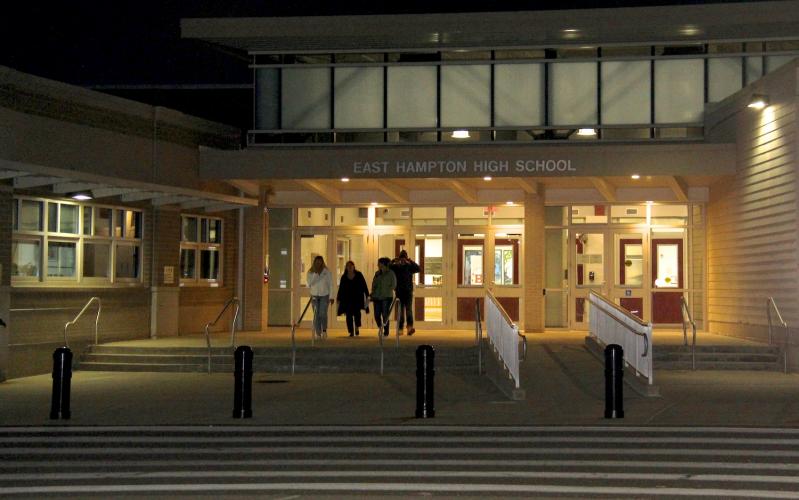This is how a random array of the South Fork’s college-bound seniors described their state of being in 2023: “Stressed.” “100 percent the most stressful year of my life.” “So stressed my hair is falling out.” And for most, well, happy new year, a thick slice of 2024 bodes more of the same.
All but two of the 20 students contacted (given the scrutiny they are still under from colleges, their names have been withheld) said the pressures of the college application process this year have weighed more heavily than what they experienced as students during the Covid-19 pandemic: the homebound lockdowns and “learning loss” of eighth grade and ninth, and then breathing and talking through masks in person all day as sophomores in the 2021-22 school year.
Sarah D’Angelo, a 2023 Pierson graduate, now a freshman at Clemson University, nailed the distinction. “With Covid stress, you’re unmotivated; your life is not normal,” she said, “but with college stress, you’re constantly doing stuff, having to go-go-go and work-work-work for all these applications.”
Over the past several weeks, seniors who submitted early have been getting word of acceptances, denials, deferments, and the “good/bad news,” as one father put it, of their names on admissions waitlists. Others have yet to press the send button on the Common App, the one-size-fits-all application that goes to all the schools they choose, due one minute before midnight on New Year’s Day.
Even with good news, relief from the anxiety is not yet in sight. Although just under a quarter of entering freshmen nationally can cover the full cost, for most students and families, financial aid offers must firm up first. Laura Anker, formerly of East Hampton and a member of the governor’s institute for immigration research and policy, said just filling out the aid forms is a major stressor, even for the most sophisticated folks among us. Imagine how daunting this can be for the newly arrived.
For this group of students, Covid’s exigencies did cause standardized test results to dip, but the scores quickly rebounded. To Sara Smith, the principal of East Hampton High School, however, that so-called “learning loss” has also meant learning gained. “They know what it’s like to have empty shelves in the grocery store,” she said. “They know what a pandemic can do, medically and socially, to a country — to the world.”
So as students, despite all they’ve endured, they’ve emerged more or less unfazed, save the early fall Devious Licks TikTok challenge their sophomore year that sparked a disturbing nationwide rash of schoolhouse pranks. Although the local iteration of the social media dare was tiny, none of the area’s keen administrators missed the yelp of liberation it signified.
Lynne Brown, East Hampton’s head guidance counselor, now in “something like” her 17th year at the school, finds this class much like those before it, with the added plus of the kindness they exhibit toward one another and their willingness to seek help.
In the college application runup, that has meant group appointments offered twice each school day, one-on-ones at will, college fairs, at least two meetings with parents, advice on college choices, bilingual group sessions for parents, non-degree advanced training, and more than one teacher willing to critique a college essay. The services offered are manifold, but so is the load advisers carry. By way of contrast, speaking only of the seniors they advise (they work with all four grades) the Ross School’s three high school guidance counselors serve 31 students; East Hampton’s six serve 285.
Still, only a few have worked with outside counselors. All of the students interviewed spoke of their heavy reliance on one another, on social media, on go-getter personal research, and on Naviance, the college planning software the schools provide. They glean information from older siblings, other recent graduates, and the college-savvy adults in their lives. One who changed school systems before ninth grade had a college dream board at 13 and several spoke of having started their web searches by then. All the same, another senior, by nature shy and reticent, with an immigrant mom, had no idea of the schools within her grasp until an angel came to the rescue with outside help — on Nov. 29.
Now, for most, atop every other consideration is cost. In several cases, it has changed a hoped-for “early decision,” which is binding, to “early action,” which is not, until the financial aid offers arrive. Ms. Brown said the costs have become so prohibitive, she’s changed the advice she gives, tending to encourage an “amazing state school” over a far pricier private one.
Cost is also a major component of the 84 (!) items on the hot pink checklist Barry Raebeck gives the students he advises from his home office in Wainscott. No one, he said, should take on $200,000 in debt for a bachelor’s degree. This year, 15 of the 17 students in Mr. Raebeck’s charge attend local schools. Several came to him through Level the Playing Field, a local nonprofit that offers his services to top students of limited means, either pro bono or on a sliding scale well below his base fee of around $5,000. As a strategy, he favors “fit” over the more typical targets-safeties-reaches approach, by which he means a good school that not only will accept the student, but one that the student and parents both like and can afford.
What most distinguishes the class of 2024 from earlier ones? Mr. Raebeck extolled the resilience he sees across racial, ethnic, and socioeconomic lines, and how good they are as students. For Ms. Smith, it is how very ambitious they are, how focused and serious they are about their futures, and how driven. “But they’re not cutthroat,” she said. “They never throw each other under the bus for their own gain when it comes to college. They do support each other.”

